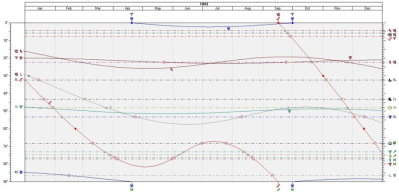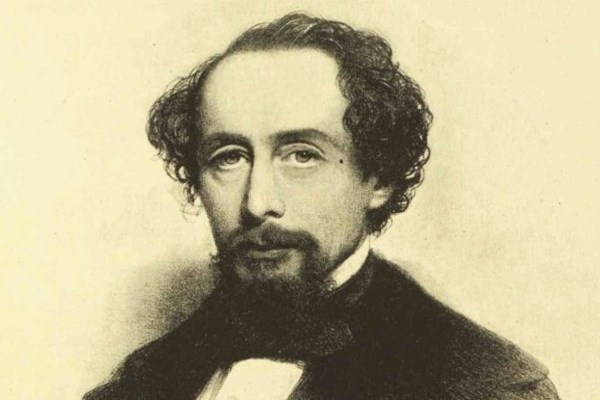By: Joseph Crane
Charles Dickens, the great novelist of the 19th century, has his “bicentennial” this month that is being celebrated across the world with parties, parades, readings; recently there have been many featured books and articles and blogs about this great literary man. He is known for many full-length novels such as Great Expectations, Oliver Twist, David Copperfield, and Tale of Two Cities, but is particularly known for having written and published the shorter A Christmas Carol that helped to revive the once-fading holiday and give it a secular tone. Many of his works, especially A Christmas Carol, have been adapted to stage, screen, and television. Dickens’ works were successful in their own time and made him a celebrity on both sides of the Atlantic. Below we will look at his chart using both modern and classical techniques.
Dickens’ novels are known for twisting plots, wry humor, many memorable characters, but especially for a strong sensitivity to social and economic injustice. A recent article in the New York Times about his intense dislike for lawyers, proclaimed him “literature’s greatest humanist”. It continues, “We can rejoice that so many of the evils he assailed with his beautiful, ferocious quill — dismal debtors’ prisons, barefoot urchin labor, an indifferent nobility — have happily been reformed into oblivion..” (New York Times article) Dickens’ works have had both social and cultural effects; he could be considered a great progressive of the modern era.
It is well-established that Dickens’ sensitivity to injustice stems from his early life. When he was twelve years old his father fell on financial difficulties and was placed in debtors’ prison, and the young Dickens was sent to live with friends of the family. He was forced to leave school and work in a factory. When his father was released from prison the young Dickens did not return home for a while but remained in the factory. He never forgave his mother for her role in this.
His early experiences gave him much material for his future novels and rendered him interested in the issue of poverty throughout his life.

When we look at his chart, we immediately see his Lot of Fortune conjunct Saturn. (Mars is in the Fourth House from the Lot of Fortune, increasing Mars’ importance as a planet of fortune for Dickens.) Although Dickens became quite wealthy through his writings, the effects of his early financial reversals never left him.
Dickens was also well-known for his immense energy. He was reputed to have walked miles through the streets of London as he was working on his novels.
Because his novels were usually written in the form of magazine installments, he wrote under intense deadline pressure. He has Scorpio rising which is governed by Mars. The fiery red planet is in sect in Dickens’ nocturnal chart, is in its own sign Aries, and “rejoices” in the Sixth Place. (Interestingly, ancient astrology called this the Place of Bad Fortune, and allows Mars strong adversity with which to do battle. Many of his novels have a strongly polemical quality to them.) We also see that Mars has a square to Saturn in Capricorn, bestowing him with a greatly-focused drive; otherwise, he could become depressed or oppressive. (We would see these negative qualities more in his personality than his public life.)
Dickens has Uranus in the First Place or House and this helped distinguish him as an independently-minded man. Both Sun in Aquarius (by square) and Mercury in Capricorn (by sextile) apply to Uranus: it “collects the light” of both planets. This helps Dickens access Uranus through his basic character (Sun) as well as his writings (Mercury).
Charles Dickens has Moon in Sagittarius that corresponds to his outsized personality and his satirical wit (a bit like Mr. Gingrich above). On the day of Dickens’ birth, the Moon was co-rising with the fixed star Antares of the nature of Mars and Jupiter (mostly Mars); thus we have further testimony about his great personal energy. Moon is also conjunct Neptune – this can give great compassion or great sentimentality, and Dickens was quite capable of both. Moon applies to Venus that is with Pluto and is also the ruler of his Seventh House. Venus is dignified (exalted in Pisces), in sect, and in its own joy in the Fifth, and this helps account for some of his charisma and public appeal.
But there we must also take up the matter of his marriage to Catherine and his dictatorial behavior as a family man. Although they had ten children, Dickens disparaged his wife publically and separated from her. At that time divorce was impossible for such a public man and they lived apart; during Dickens’ lifetime (as there is now) there was speculation that he kept the actress Ellen Ternan as a mistress: she did live in a house he had bought for her and he supported her for many years. Ordinarily, Venus conjunct Pluto cannot describe a person happy in a watered-down relationship or marriage, and it might have been difficult for Dickens to maintain continual interest in his rather conventional marriage. There is a lot called “The Lot of Marriage” that derives from the distance between the planets Saturn to Venus, and that distance is tacked onto the Ascendant: this would help us understand marriage as an institutional commitment. Dickens’ Lot of Marriage falls in 14 Capricorn and so is close to its governing planet, Saturn. Dickens could have either enjoyed the conventions of marriage or would have hated them for being oppressive: Venus conjunct Pluto would imply that he would hate them and want stronger romantic stuff.
At first glance, Dickens’ Mercury doesn’t stand out. It’s oriental –but this is not a particular benefit for Mercury in a nocturnal chart. Mercury travels exactly one degree that day so that Mercury is at its greatest elongation from the Sun and is about to move more quickly on its way to a conjunction. Nor is this particularly outstanding. In Capricorn, it’s in the “house” and terms of Saturn and we get a sense of Dickens’ Mercury’s strongly disciplined nature – as befitting one who would write all these very good novels.
A closer look at Mercury’s aspects is very helpful and here we depart from the Ptolemaic aspect realms and consider the quintile family, one that becomes important when considering talent. Mercury is 18 degrees from Saturn that is about 72 degrees from Venus and Pluto. In a Fifth Harmonic chart, that measures conjunctions from 72 degrees (one-fifth of a circle), Mercury will be in square to Saturn-Venus-Pluto. In a Fifth Harmonic chart one does not consider signs or houses – just aspects.
Saturn together with Pluto is both oppressive and transformative – its learning is through the “school of life” and its result, at best, is bravery in the face of life’s difficulties. Adding Venus to the mix allows for artistic expression, especially since Mercury is also in this configuration. Dickens could have been a progressive politician but instead, he was an artist.
We also see a reflection of the closeness of the sextile between Mercury and Uranus. In Dickens’ radical natal chart the two planets are 55 minutes from an exact sextile: multiply this number by five to convert to a Fifth Harmonic, and the distance from exactness is just within 5 degrees.

I close with a consideration of A Christmas Carol, his most famous and popularly influential work. Because this short novel helped re-establish Christmas as a great holiday, it may be the most influential literary work in the modern era. We all know its story with its sour depiction of deprivation and cruelty, and its happily redemptive ending: indeed it is a paradigm of much of the literary and media production of the holiday season.
He wrote it quickly in the autumn of 1843 and it was published in mid-December of that year, depicting Christmas of 1843. This was a year after his first visit to American and during a time in which he has seen much suffering of the children of poor people and having become interested in promoting Christmas as a humanitarian holiday. What were Dickens’ transits like that year? Let’s first look at the graphic ephemeris (for a better view, click on the image to open it in another window).
 Remember that the moving lines from the left and top sides depict the transiting planets, and the straight lines from the right side are the natal planets. They are arranged so that the planets in cardinal signs are at the top, those in fixed signs are in the middle, and those in mutable signs are at the bottom. An intersection between a moving line and a straight line is a transit – by conjunction, square, or opposition.
Remember that the moving lines from the left and top sides depict the transiting planets, and the straight lines from the right side are the natal planets. They are arranged so that the planets in cardinal signs are at the top, those in fixed signs are in the middle, and those in mutable signs are at the bottom. An intersection between a moving line and a straight line is a transit – by conjunction, square, or opposition.
Just above the line of 50 degrees we can see transiting Neptune conjuncting Dickens’ Sun in mid-January, moving ahead to go retrograde in early summer and during the time of writing was stationary, in conjunction with his natal Sun. Here we’re seeing Neptune in its best form, as a planet of compassion, for the short novel shed light in a compassionate way even on the miserly Ebenezer Scrooge.
The hardness of the suffering of A Christmas Carol is clear from another set of transits for 1843. On the left side, we see that from the beginning of the year Saturn was in Capricorn and Pluto in Aries; during the year both Pluto and Saturn were transiting Mercury. Indeed, during the time he was writing the novel, Pluto was at station in square to his Mercury and Saturn would make contact, both retrograde and direct.
Giving birth to A Christmas Carol was an emotionally wrenching experience but we have the benefit. The novel was a sensation when it came to press and the rest is history.



